Hybrid Energy Management System for Operation of Wind Farm System Considering Grid-Code Constraints
Abstract
1. Introduction
- A hybrid energy management system is developed to optimize the operation of a large WF system by combining both centralized and decentralized approaches. This makes the design of communication network much simpler. Instead of developing a large EMS for the entire WF system, each cluster is managed by a local EMS, i.e., cluster EMS. The mismatch power in the WF system is also simply updated through an information-sharing process between CEMSs and TSO in a distributed manner.
- A two-stage optimization is also proposed to optimize the operation of the WF system to reduce the power deviation for set-points of WTGs. Moreover, CEMSs and TSOs share information to optimally determine the amount of increase/decrease for each cluster using diffusion strategy. The use of diffusion strategy helps to reduce the time for sharing information in a distributed way.
- Different grid-code constraints are given by TSOs for the operation of WF. These constraints require the WF system to control its output power in each specific operation situation. The proposed method is also developed considering several important grid-code constraints. The simulation results prove that the WF system can adjust its output with any requirement from TSO.
2. System Model
2.1. Configuration of Wind Farm System
2.2. Grid-Code Constraints
3. Proposed Operation Strategy
- Stage 1—Information sharing: In this stage, the CEMSs and TSO will share information to determine the mismatch power between required power from TSO and current output power of WF. This amount of mismatch power is compensated by adjusting the output power of clusters.
- Stage 2—Cluster optimization: In this stage, each CEMS will optimize the set-points of WTGs for fulfilling the power mismatch amount receiving from stage 1 and minimize the power deviation for the set-points of WTGs inside the cluster.
3.1. Stage 1: Distributed Approach for Sharing Information among Clusters and TSO
| Algorithm 1 Diffusion strategy for sharing information | |||
| 1: | Input parameters, i.e., | ||
| 2: | Determine adjacent matrix A using Equation (1) | ||
| 3: | while error < available value do | ||
| 4: | for all i < N do | ||
| 5: | |||
| 6: | |||
| 7: | End | ||
| 8: end while | |||
3.2. Stage 2: Centralized Approach for Optimal Operation in Clusters
4. Mathematical Model
4.1. Diffusion Strategy-Based Information-Sharing
4.2. MILP-Based Optimization
5. Numerical Results
5.1. Hierarchical Control Structure of WF
- Primary control level is the fastest level to ensure the reference tracking of frequency and voltage for each WTGs.
- Secondary control level helps improve power quality and transient stability in WF system.
- Tertiary control level is designed to determine the optimal set-point for each WTG to achieve a common operation objective of the WF system.
5.2. Input Data and Case Study
- Rated power: 10 MW
- Minimum operation point: 1 MW
- Maximum ramp-up/ramp-down: 2 MW during 30 seconds
- At t1, WF is initially operated in limited power mode with limited power at 100 MW.
- At t2, the limited power increases from 100 MW to 120 MW. The power mismatch in the WF system is 20 MW and therefore the WTGs will be controlled to increase their set-points to balance this amount of mismatch power.
- At t3, WF is switched to the reserve mode. A certain amount of reserve power is required in WF system. Therefore, the set-point of WTGs should be again determined to fulfill the requirement for reserve capacity. In this case study, the reserve capacity is required to be 20%.
5.3. Simulation Results
5.3.1. Case 1: The WF System Initially Operates During t1–t2 with Limited Power at 100 MW
5.3.2. Case 2: The Limited Power Increases to 120 MW at t2
5.3.3. Case 3: WF Changes to Reverse Power Mode at t3 (20% for Reserve Power)
6. Conclusions
Author Contributions
Funding
Conflicts of Interest
Nomenclatures
| Abbreviations | |
| CEMS | Cluster energy management system |
| EMS | Energy management system |
| MILP | Mixed-integer linear programming |
| MPPT | Maximum power point tracking |
| RES | Renewable energy source |
| TSO | Transmission system operator |
| WF | Wind farm |
| WTG | Wind turbine generator |
| Sets | |
| T | Scheduling horizon |
| Ni | Set of WTGs |
| I | Set of clusters |
| Indices | |
| t | Index of intervals |
| n, m | Index of WTGs |
| i | Index of clusters |
| Parameters | |
| A | Adjacent matrix for the communication network |
| xk,i | State of agent i at iteration k |
| Stochastic gradient of intermediate state φ for agent i at iteration k | |
| Rated power of WTG n in cluster i | |
| Minimum operation point of WTG n in cluster i | |
| Available power of WTG n in cluster i at t | |
| State of WTG n in cluster i at t | |
| Mismatch power from stage 1 of cluster i at t | |
| Penalty for mismatch power of cluster i at t | |
| Penalty for power deviation for set-points of WTG m and WTG n in cluster i at t | |
| Power deviation for set-points of WTG m and WTG n in cluster i at t | |
| Limited power at t | |
| Reserve power at t | |
| Ramp-down rate of WTG n in cluster i | |
| Ramp-up rate of WTG n in cluster i | |
References
- Bull, S.R. Renewable energy today and tomorrow. Proc. IEEE 2001, 89, 1216–1226. [Google Scholar] [CrossRef]
- Yaramasu, V.; Wu, B.; Sen, P.C.; Kouro, S.; Narimani, M. High-power wind energy conversion systems: State-of-the-art and emerging technologies. Proc. IEEE 2015, 103, 740–788. [Google Scholar] [CrossRef]
- Pao, L.Y.; Johnson, K. Control of wind turbines. IEEE Control Syst. Mag. 2011, 31, 44–62. [Google Scholar]
- Fichaux, N.; Singh, G.; Lee, W.J.; Vinci, S. 30 years of policies for wind energy: Lessons from 12 markets. 2012. Available online: https://www.irena.org/DocumentDownloads/Publications/-GWEC_WindReport_All_web%20display.pdf (accessed on 25 November 2019).
- Ng, C.; Ran, L. Offshore Wind Farms: Technologies, Design and Operation; Woodhead Publishing: Cambridge, UK, 2016. [Google Scholar]
- Tsili, M.; Papathanassiou, S. A review of grid code technical requirements for wind farms. IET Renew. Power Gener. 2009, 3, 308–332. [Google Scholar] [CrossRef]
- Abdeltawab, H.H.; Mohamed, Y.A.R.I. Robust energy management of a hybrid wind and flywheel energy storage system considering flywheel power losses minimization and grid-code constraints. IEEE Trans. Ind. Electron. 2016, 63, 4242–4254. [Google Scholar] [CrossRef]
- Mohseni, M.; Islam, S.M. Review of international grid codes for wind power integration: Diversity, technology and a case for global standard. Renew. Sustain. Energy Rev. 2012, 16, 3876–3890. [Google Scholar] [CrossRef]
- Zhao, H.; Wu, Q.; Wang, J.; Liu, Z.; Shahidehpour, M.; Xue, Y. Combined active and reactive power control of wind farms based on model predictive control. IEEE Trans. Energy Convers. 2017, 32, 1177–1187. [Google Scholar] [CrossRef]
- Wang, M.; Mu, Y.; Jia, H.; Wu, J.; Yu, X.; Qi, Y. Active power regulation for large-scale wind farms through an efficient power plant model of electric vehicles. Appl. Energy 2017, 185, 1673–1683. [Google Scholar] [CrossRef]
- Ziping, W.U.; Wenzhong, G.A.O.; Tianqi, G.A.O.; Weihang, Y.A.N.; Zhang, H.; Shijie, Y.A.N.; Xiao, W.A.N.G. State-of-the-art review on frequency response of wind power plants in power systems. J. Modern Power Syst. Clean Energy 2018, 6, 1–16. [Google Scholar]
- Di Marzio, G.; Eek, J.; Tande, J.O.; Fosso, O.B. Implication of grid code requirements on reactive power contribution and voltage control strategies for wind power integration. In Proceedings of the International Conference on Clean Electrical Power, Capri, Italy, 21–23 May 2007; pp. 154–158. [Google Scholar]
- Moawwad, A.; El Moursi, M.S.; Xiao, W. Advanced fault ride-through management scheme for VSC-HVDC connecting offshore wind farms. IEEE Trans. Power Syst. 2016, 31, 4923–4934. [Google Scholar] [CrossRef]
- Justo, J.J.; Mwasilu, F.; Jung, J.W. Doubly-fed induction generator based wind turbines: A comprehensive review of fault ride-through strategies. Renew. Sustain. Energy Rev. 2015, 45, 447–467. [Google Scholar] [CrossRef]
- Hansen, A.D.; Sørensen, P.; Iov, F.; Blaabjerg, F. Centralised power control of wind farm with doubly fed induction generators. Renew. Energy 2006, 31, 935–951. [Google Scholar] [CrossRef]
- De Paola, A.; Angeli, D.; Strbac, G. Scheduling of wind farms for optimal frequency response and energy recovery. IEEE Trans. Control Syst. Technol. 2016, 24, 1764–1778. [Google Scholar] [CrossRef]
- Hossain, M.J.; Pota, H.R.; Kumble, C. Decentralized robust static synchronous compensator control for wind farms to augment dynamic transfer capability. J. Renew. Sustain. Energy 2010, 2, 1–20. [Google Scholar] [CrossRef]
- Zhong, S.; Wang, X. Decentralized model-free wind farm control via discrete adaptive filtering methods. IEEE Trans. Smart Grid 2016, 9, 2529–2540. [Google Scholar] [CrossRef]
- Kristalny, M.; Madjidian, D. Decentralized feedforward control of wind farms: Prospects and open problems. In Proceedings of the 50th IEEE Conference on Decision and Control and European Control Conference, Orlando, FL, USA, 12–15 December 2011; pp. 3464–3469. [Google Scholar]
- de Azevedo, R.; Cintuglu, M.H.; Ma, T.; Mohammed, O.A. Multiagent-based optimal microgrid control using fully distributed diffusion strategy. IEEE Trans. Smart Grid 2017, 8, 1997–2008. [Google Scholar] [CrossRef]
- Bui, V.H.; Hussain, A.; Kim, H.M. Optimal operation of microgrids considering auto-configuration function using multiagent system. Energies 2017, 10, 1484. [Google Scholar] [CrossRef]
- Kong, X.; Liu, X.; Ma, L.; Lee, K.Y. Hierarchical distributed model predictive control of standalone wind/solar/battery power system. IEEE Trans. Syst. Man Cybern. Syst. 2019, 49, 1570–1581. [Google Scholar] [CrossRef]
- Xu, Y.; Li, Z. Distributed optimal resource management based on the consensus algorithm in a microgrid. IEEE Trans. Ind. Electron. 2014, 62, 2584–2592. [Google Scholar] [CrossRef]
- Bui, V.H.; Hussain, A.; Kim, H.M. Diffusion strategy-based distributed operation of microgrids using multiagent system. Energies 2017, 10, 903. [Google Scholar] [CrossRef]
- Sayed, A.H. Adaptive networks. Proc. IEEE 2014, 102, 460–497. [Google Scholar] [CrossRef]
- McCarl, B.A.; Spreen, T.H. Applied Mathematical Programming Using Algebraic Systems. Dept. Agricult. Econ., Texas A&M Univ.: College Station, TX, USA; pp. 1–567. Available online: http://agecon2.tamu.edu/people/faculty/mccarlbruce/mccspr/thebook.pdf (accessed on 25 November 2019).
- Xu, J.; Yi, X.; Sun, Y.; Lan, T.; Sun, H. Stochastic optimal scheduling based on scenario analysis for wind farms. IEEE Trans. Sustain. Energy 2017, 8, 1548–1559. [Google Scholar] [CrossRef]
- Ebrahimi, F.M.; Khayatiyan, A.; Farjah, E. A novel optimizing power control strategy for centralized wind farm control system. Renew. Energy 2016, 86, 399–408. [Google Scholar] [CrossRef]
- Guo, Q.; Sun, H.; Wang, B.; Zhang, B.; Wu, W.; Tang, L. Hierarchical automatic voltage control for integration of large-scale wind power: Design and implementation. Electr. Power Syst. Res. 2015, 120, 234–241. [Google Scholar] [CrossRef]
- Bui, V.H.; Hussain, A.; Kim, H.M. Optimal operation of wind farm for reducing power deviation considering grid-code constraints and events. IEEE Access 2019, 7, 139058–139068. [Google Scholar] [CrossRef]
- IBM ILOG CPLEX V12.6 User’s Manual for CPLEX 2015, CPLEX Division; ILOG: Incline Village, NV, USA, 2015.
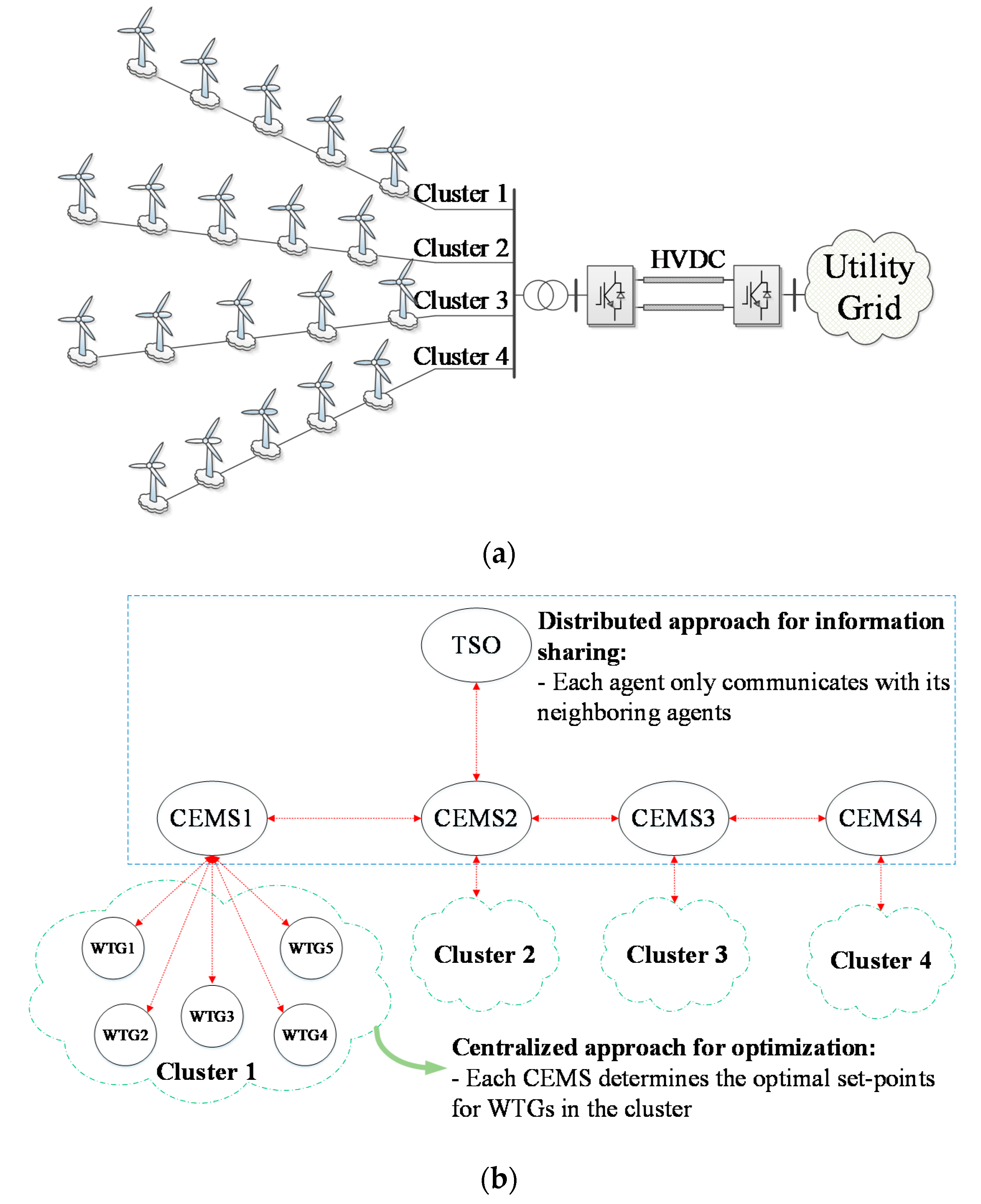
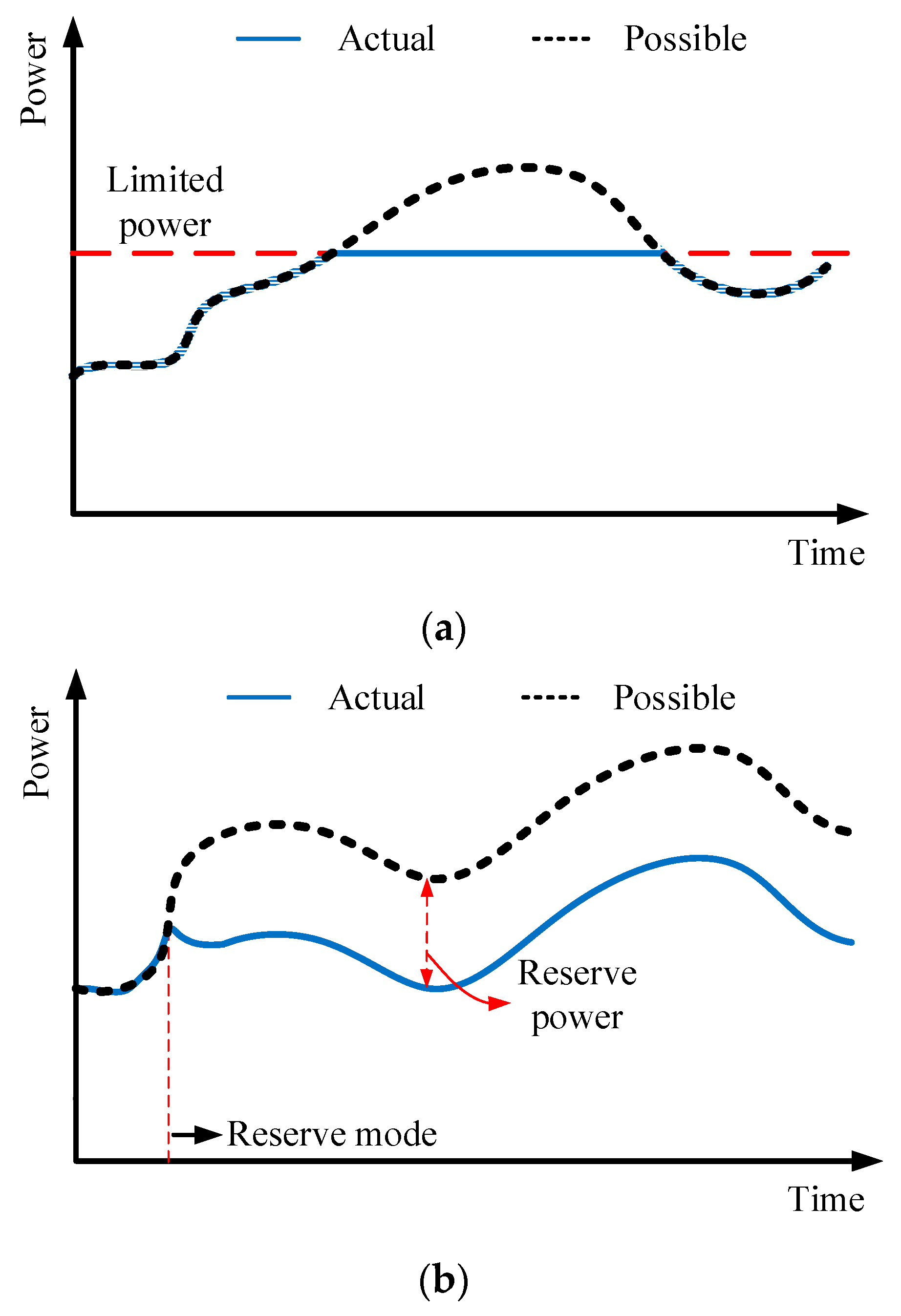
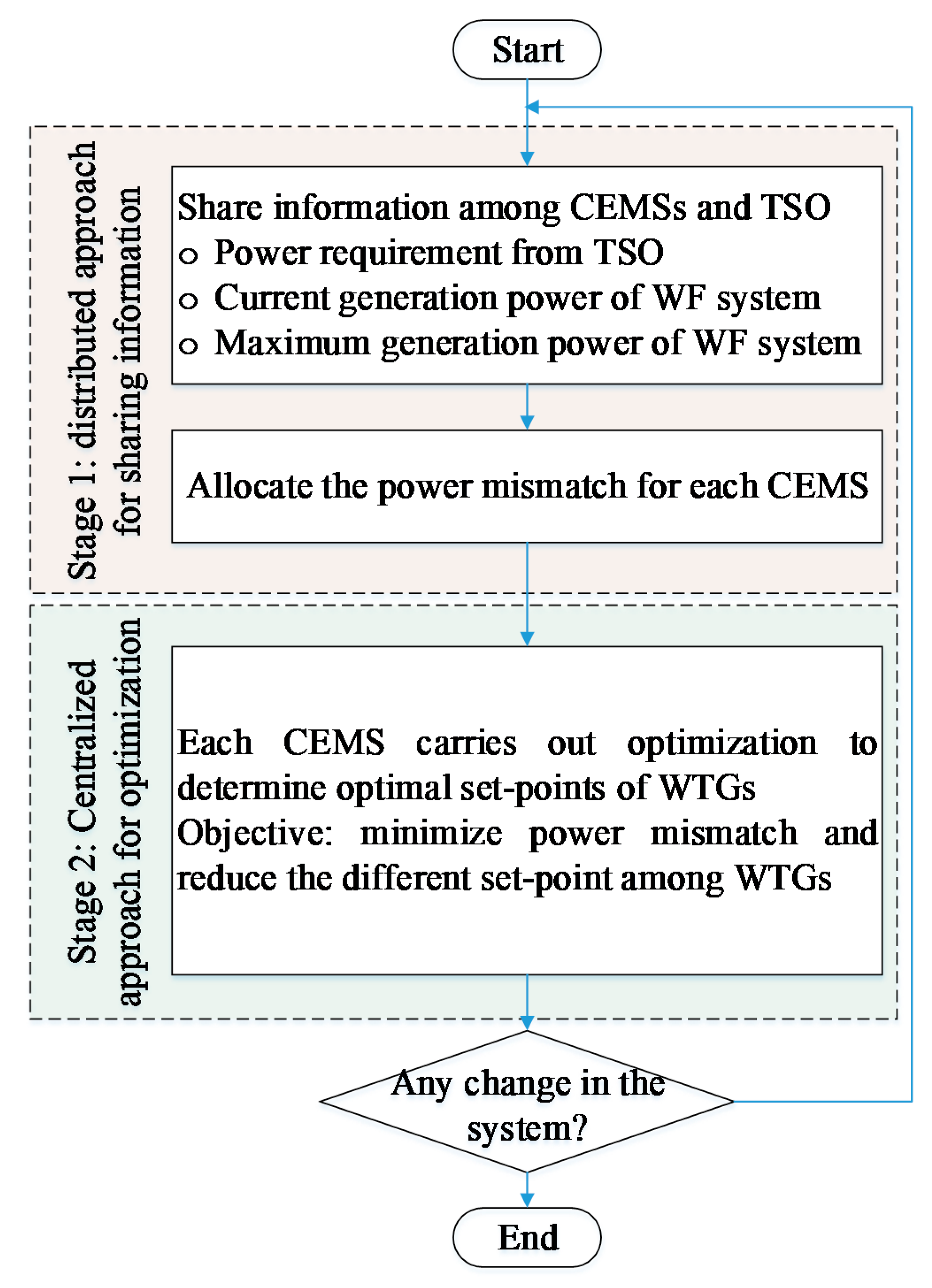
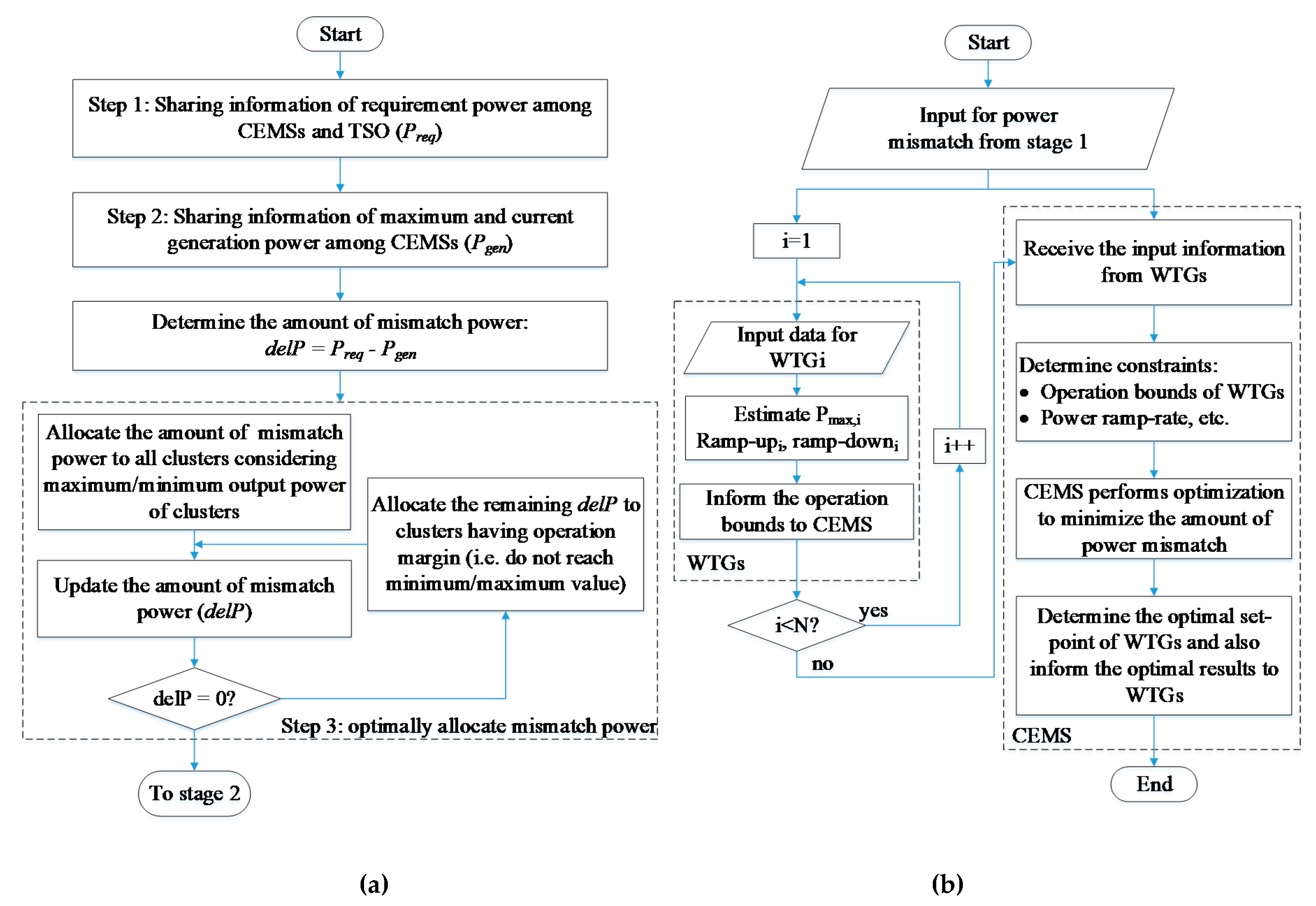
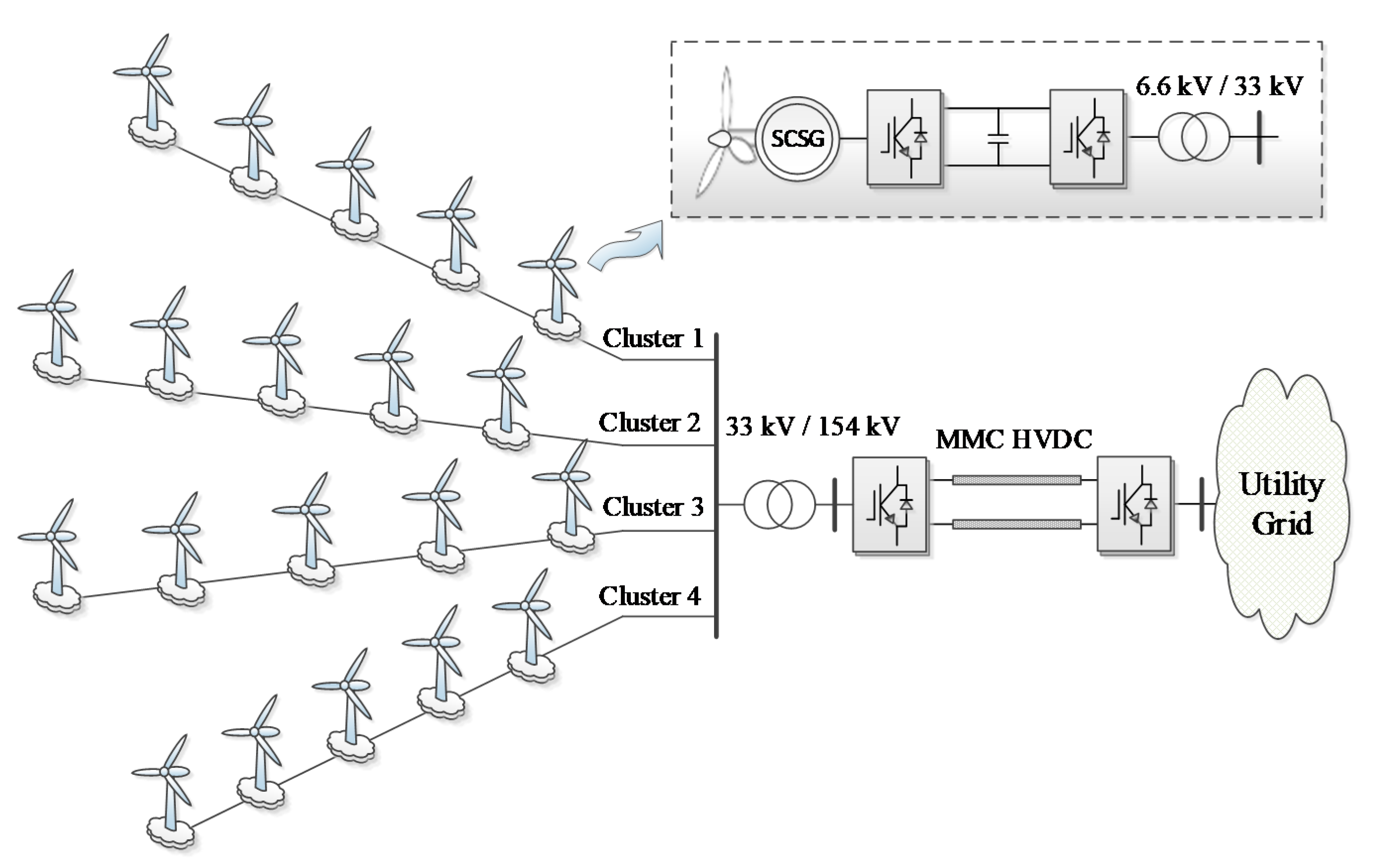
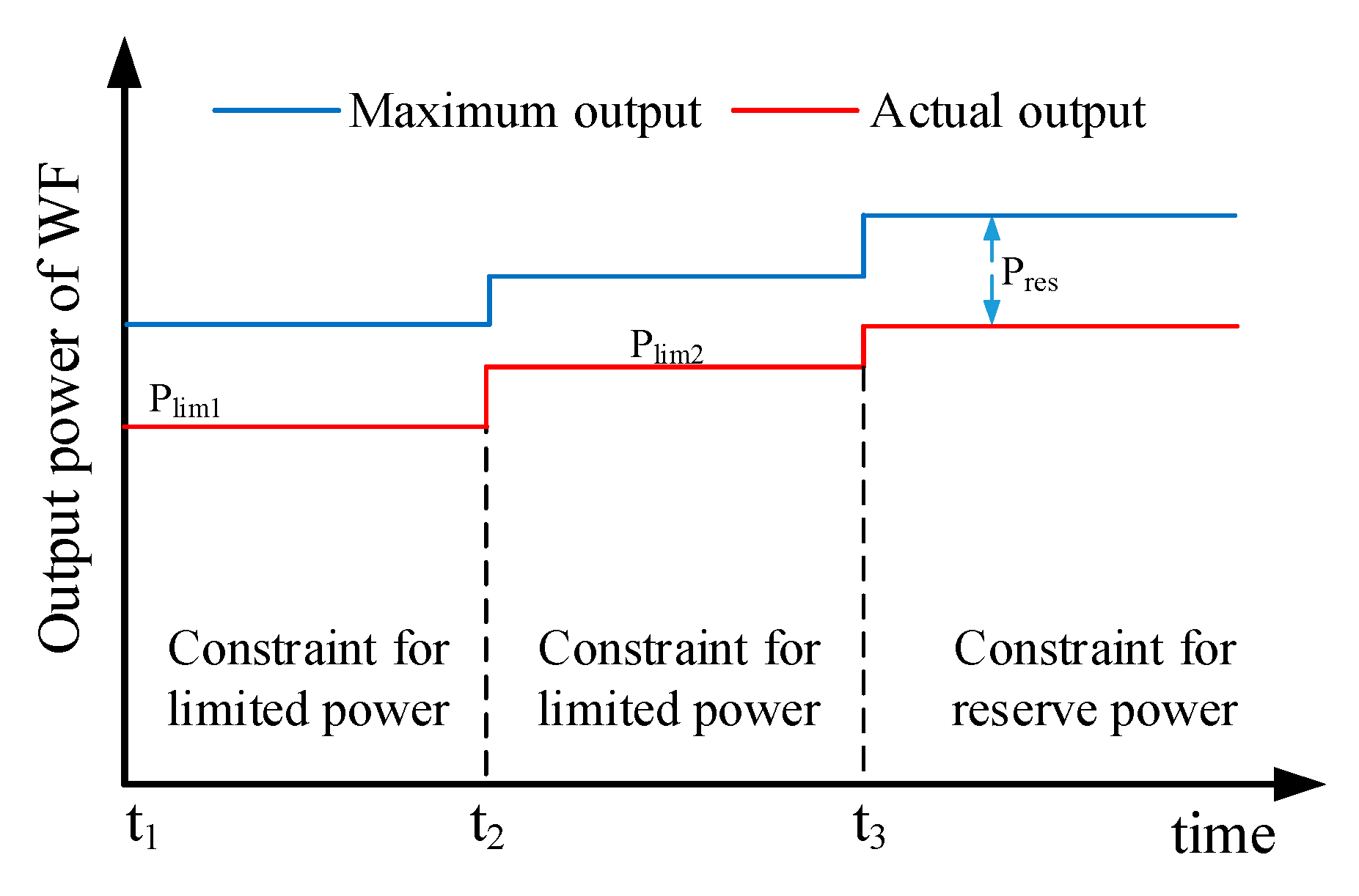
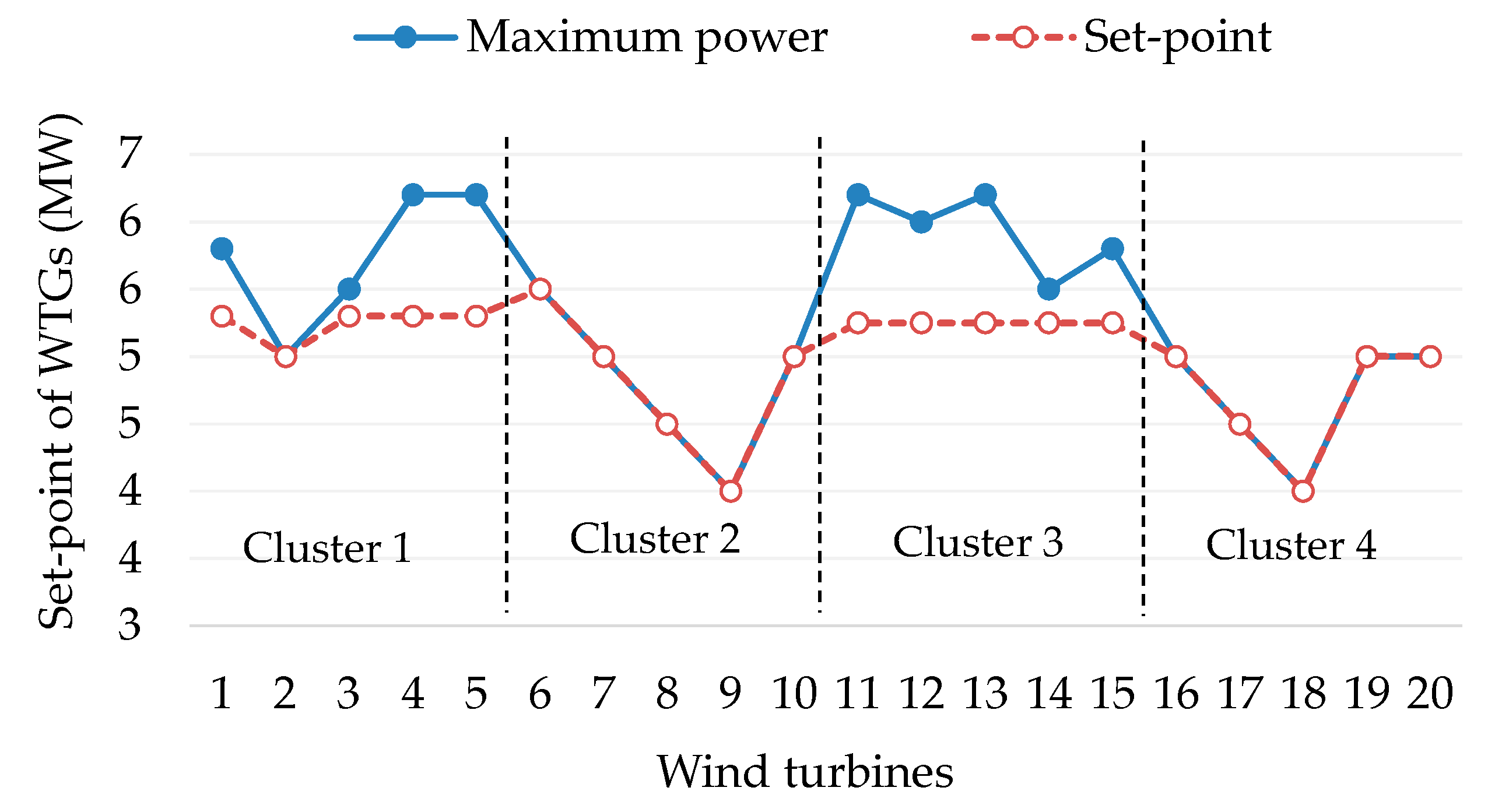
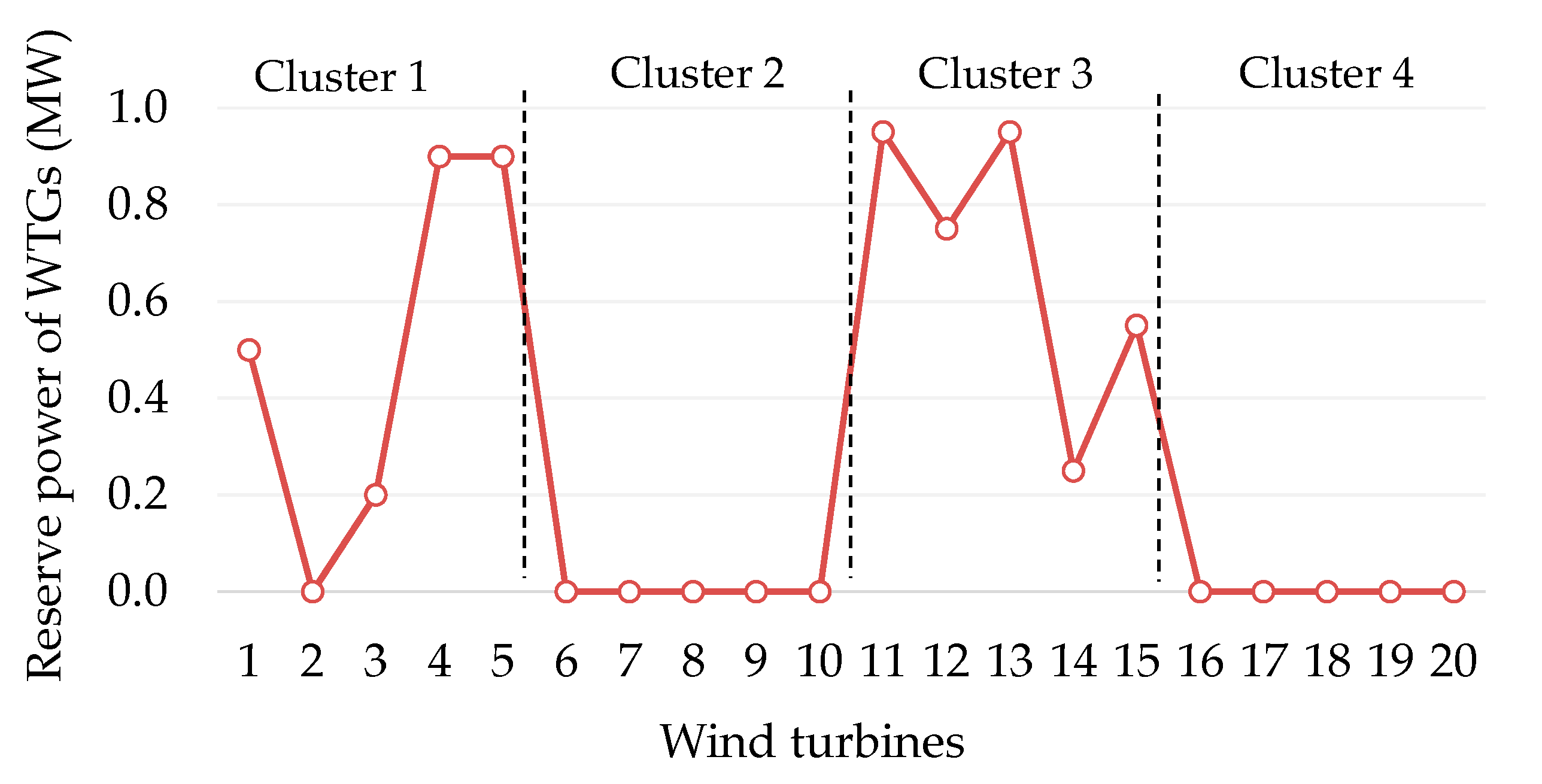
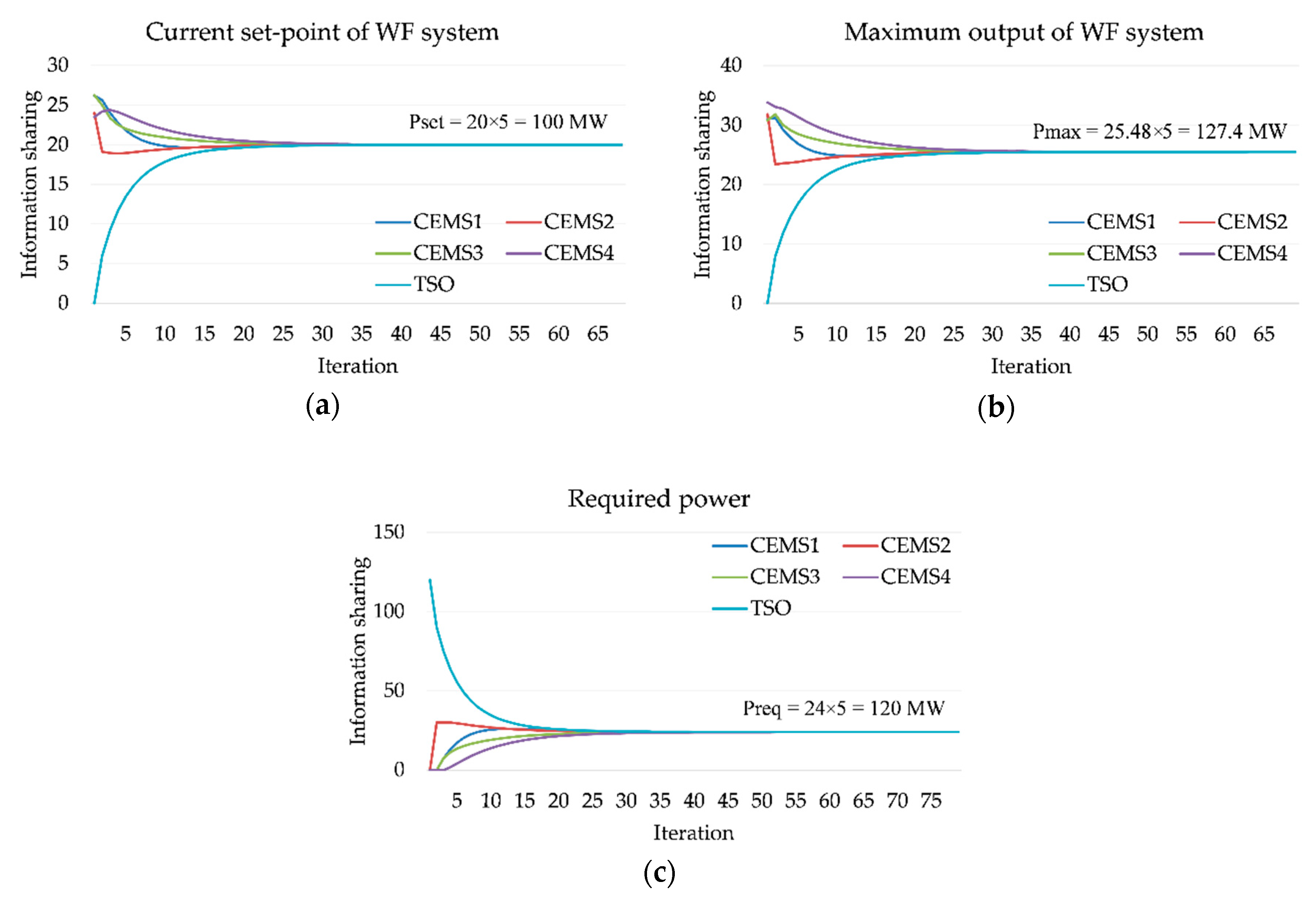
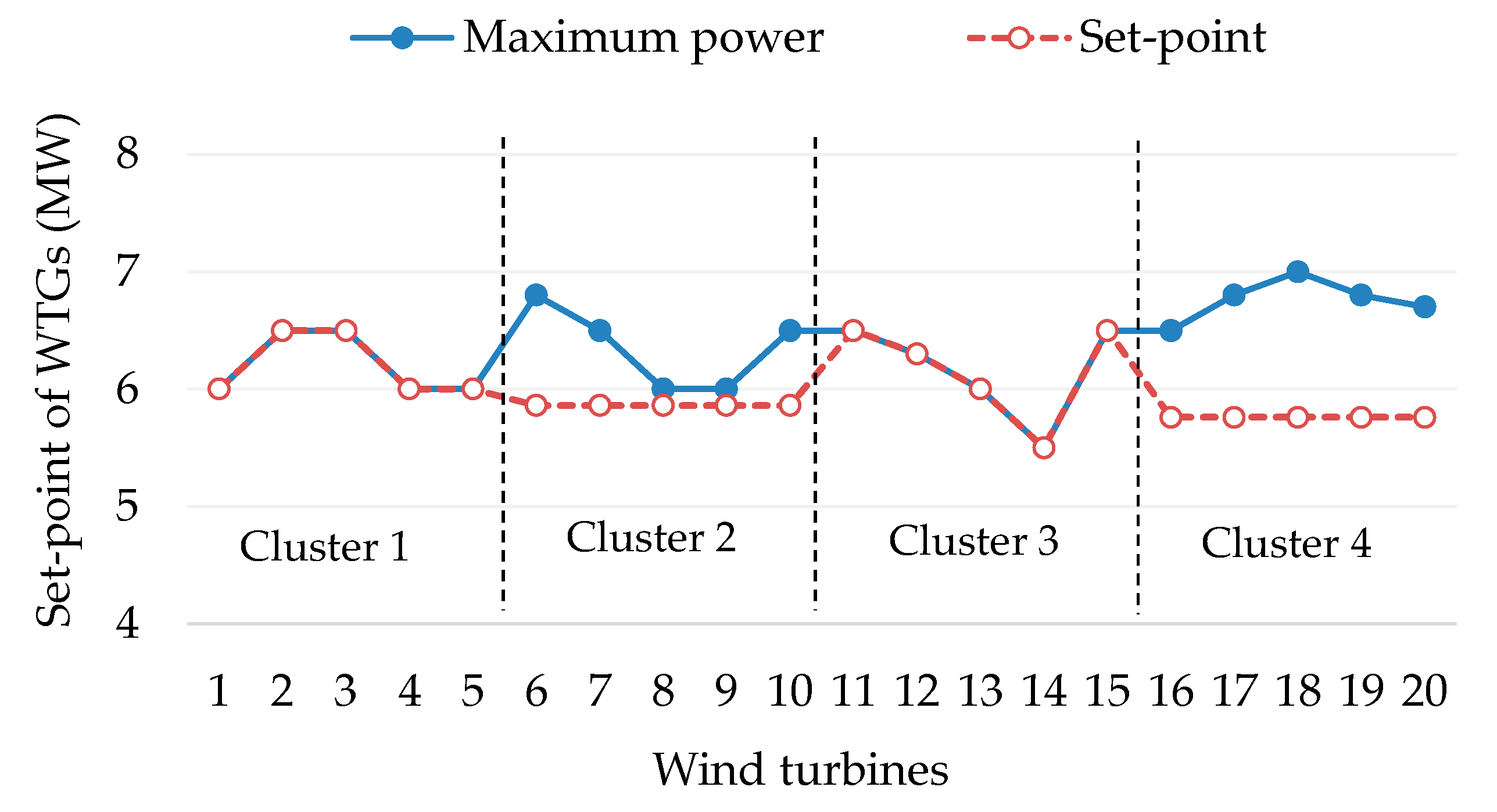
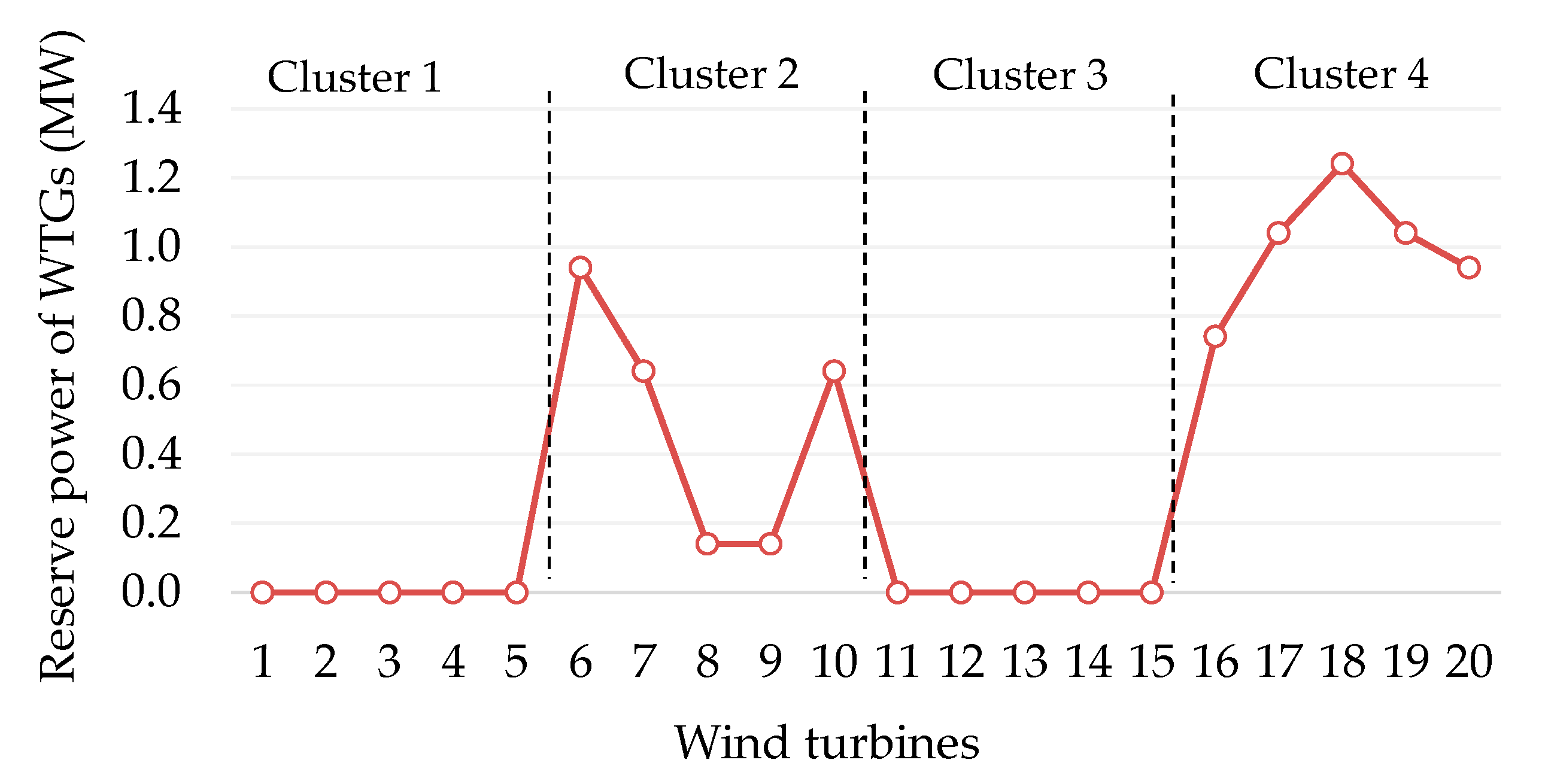
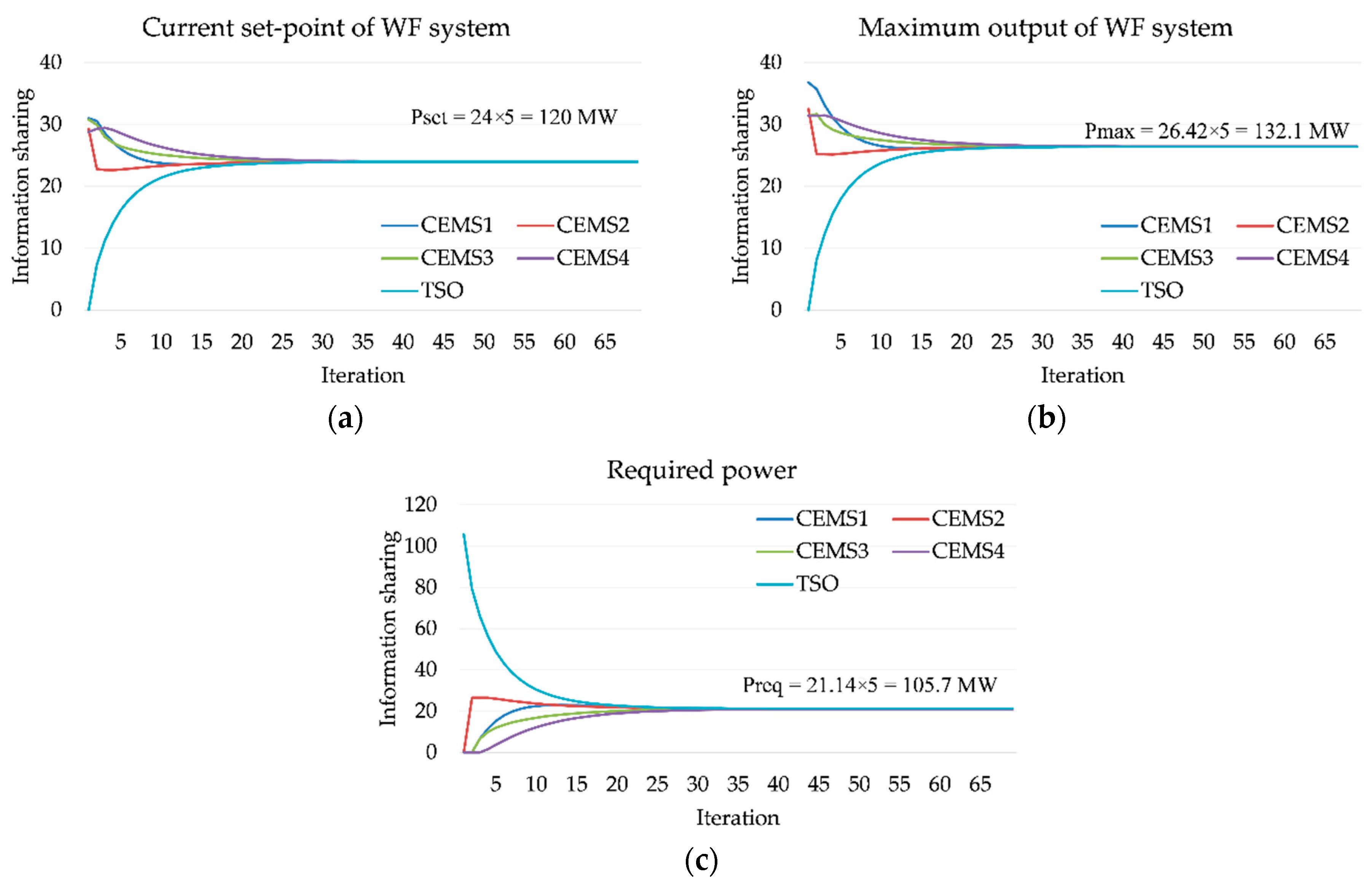
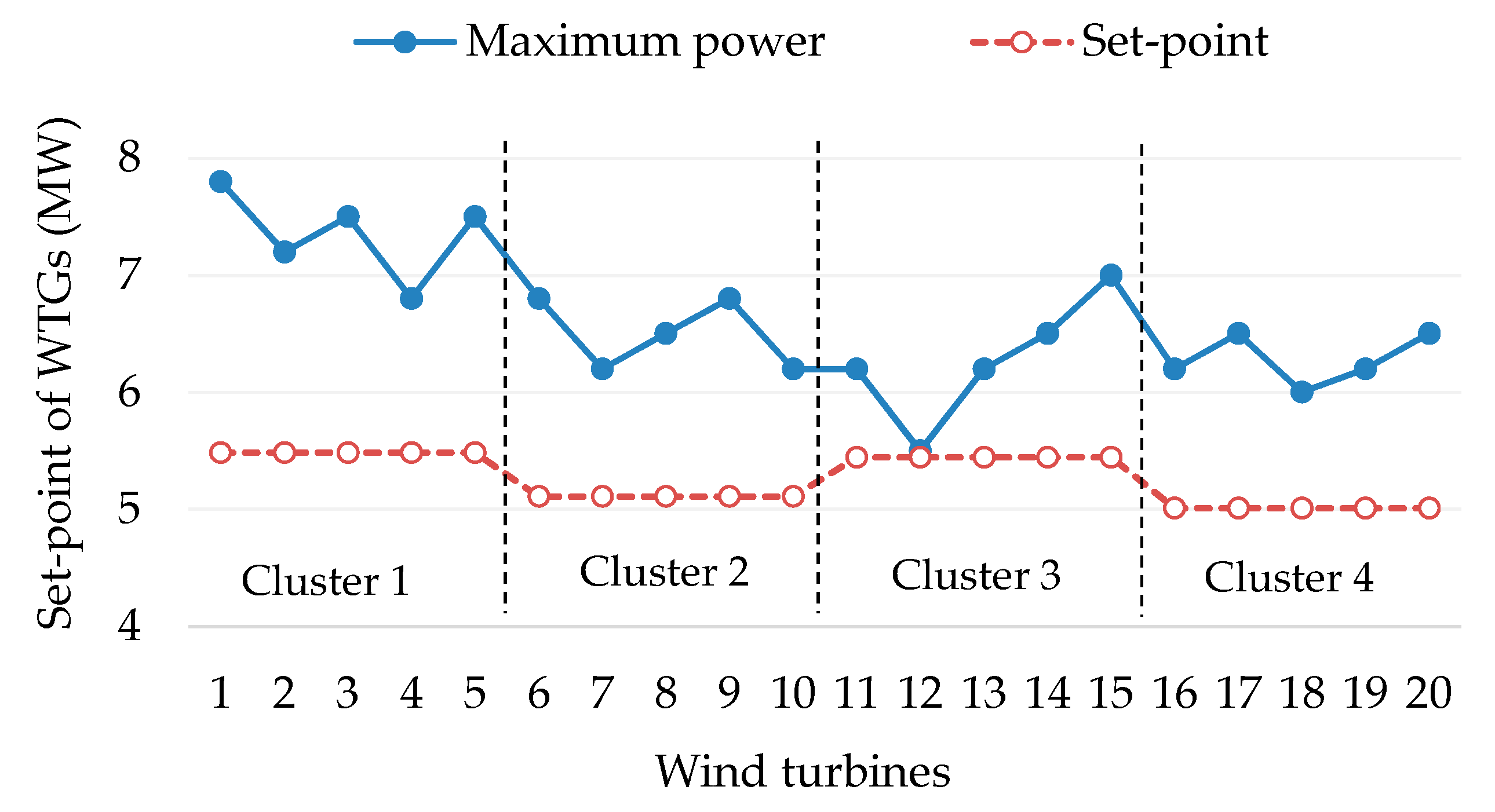
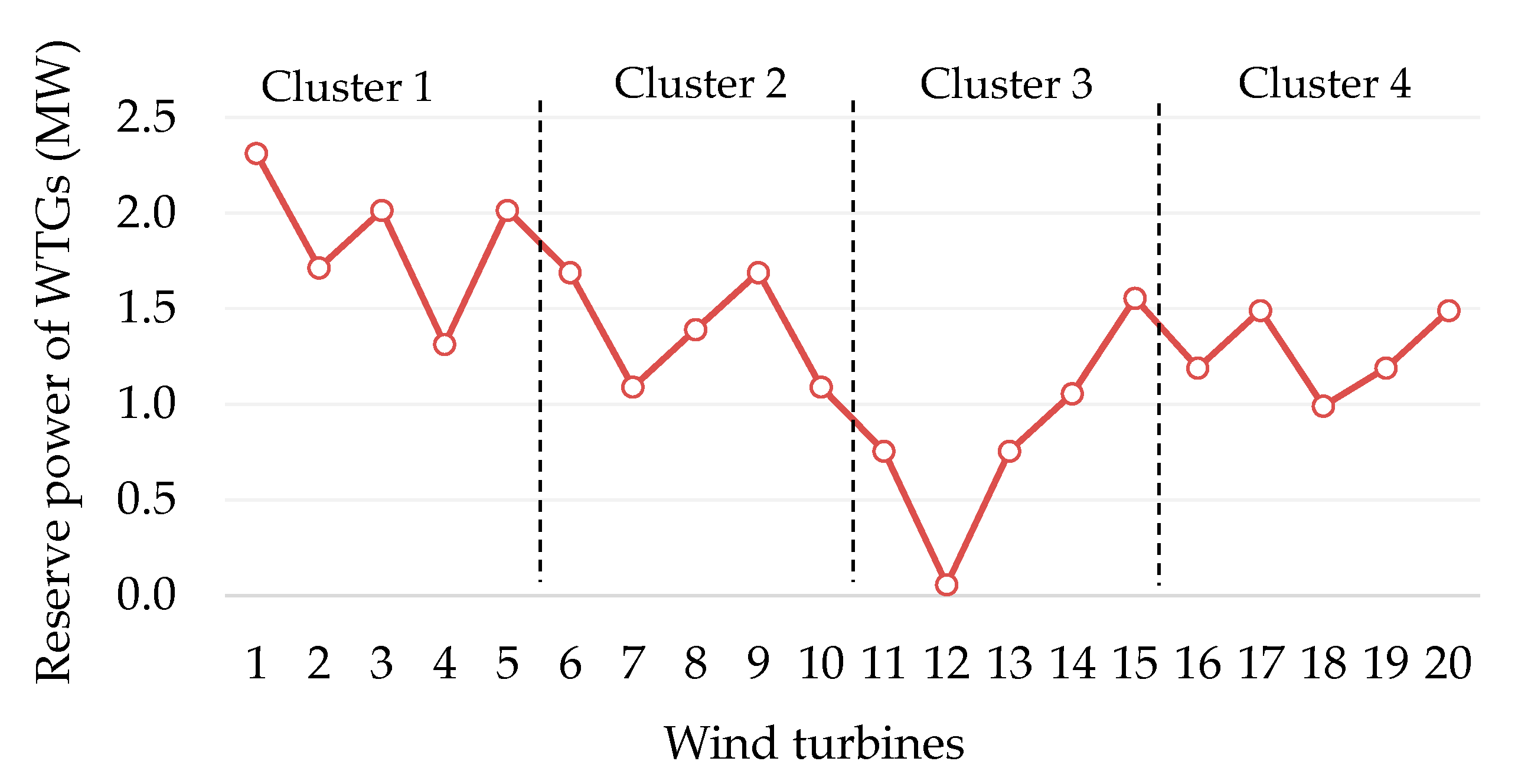
| Cluster 1 | WTG1 | WTG2 | WTG3 | WTG4 | WTG5 | Total (MW) |
| t1 | 5.8 | 5 | 5.5 | 6.2 | 6.2 | 28.7 |
| t2 | 6 | 6.5 | 6.5 | 6 | 6 | 31 |
| t3 | 7.8 | 7.2 | 7.5 | 6.8 | 7.5 | 36.8 |
| Cluster 2 | WTG6 | WTG7 | WTG8 | WTG9 | WTG10 | - |
| t1 | 5.5 | 5 | 4.5 | 4 | 5 | 24 |
| t2 | 6.8 | 6.5 | 6 | 6 | 6.5 | 31.8 |
| t3 | 6.8 | 6.2 | 6.5 | 6.8 | 6.2 | 32.5 |
| Cluster 3 | WTG11 | WTG12 | WTG13 | WTG14 | WTG15 | - |
| t1 | 6.2 | 6 | 6.2 | 5.5 | 5.8 | 29.7 |
| t2 | 6.5 | 6.3 | 6 | 5.5 | 6.5 | 30.8 |
| t3 | 6.2 | 5.5 | 6.2 | 6.5 | 7 | 31.4 |
| Cluster 4 | WTG16 | WTG17 | WTG18 | WTG19 | WTG20 | - |
| t1 | 5 | 4.5 | 4 | 5 | 5 | 23.5 |
| t2 | 6.5 | 6.8 | 7 | 6.8 | 6.7 | 33.8 |
| t3 | 6.2 | 6.5 | 6 | 6.2 | 6.5 | 31.4 |
© 2019 by the authors. Licensee MDPI, Basel, Switzerland. This article is an open access article distributed under the terms and conditions of the Creative Commons Attribution (CC BY) license (http://creativecommons.org/licenses/by/4.0/).
Share and Cite
Bui, V.-H.; Hussain, A.; Lee, W.-G.; Kim, H.-M. Hybrid Energy Management System for Operation of Wind Farm System Considering Grid-Code Constraints. Energies 2019, 12, 4672. https://doi.org/10.3390/en12244672
Bui V-H, Hussain A, Lee W-G, Kim H-M. Hybrid Energy Management System for Operation of Wind Farm System Considering Grid-Code Constraints. Energies. 2019; 12(24):4672. https://doi.org/10.3390/en12244672
Chicago/Turabian StyleBui, Van-Hai, Akhtar Hussain, Woon-Gyu Lee, and Hak-Man Kim. 2019. "Hybrid Energy Management System for Operation of Wind Farm System Considering Grid-Code Constraints" Energies 12, no. 24: 4672. https://doi.org/10.3390/en12244672
APA StyleBui, V.-H., Hussain, A., Lee, W.-G., & Kim, H.-M. (2019). Hybrid Energy Management System for Operation of Wind Farm System Considering Grid-Code Constraints. Energies, 12(24), 4672. https://doi.org/10.3390/en12244672







